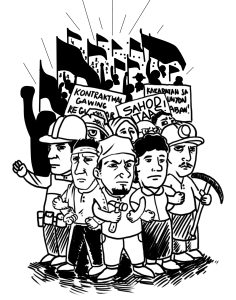Slave-like wages and ballooning profits


In two decades since 1999, the net income of the 1,000 biggest companies in the Philippines grew by 946%. On the other hand, during the same period, the slave-like wages of workers rose by only 140% from ₱224 to ₱537 in the National Capital Region, where minimum wages are highest. Their net income slightly decreased in 2020 amid the most violent and one of the longest lockdowns in the world. But in 2021, these companies not only recovered, but surpassed the ₱1.455 billion income in 2019 to ₱1.817 billion.
Amid this all, worker’s minimum wages remained stuck at ₱537 in the national capital. After required deductions (SSS, Philhealth, Pag-ibig), a worker brings home less than ₱500 a day. In 2022, minimum wages in NCR were ordered increased by a paltry ₱33 to ₱570. However, this was only eroded by inflation. In 2022, the real value of wages was only ₱495.
At the outset of 2023, big capitalists further boasted of huge corporate income even as wages remained low. They sang in chorus with the state in bragging about the 6.4% growth in gross domestic product, and the supposed return of the Philippine economy to the road of “high growth.”
Ramon Ang’s San Miguel Corporation led in bragging about how its income rose by 27% to ₱17.7 billion from January to March. The revenue of its companies rose by 9% to ₱346.7 billion. These came primarily from food and drinks manufacturing, toll charges and Petron. Moreover, Ang expects further increases in his companies’ income in the coming months.
The companies of the Zobel-Ayala family also reported an increase in income by 31% to ₱10.2 billion in the same period. Companies which raked in large amount of profits include the Bank of the Philippine Islands, Ayala Land Inc. and Globe Telecom.
Meanwhile, the Sy family’s SM Investments reported a 33% increase in income to ₱17.3 billion. The Sy-owned companies are notorious for employing contractual workers who receive unlivable wages and minimal benefits, if any.
Together with the rise in corporate income, the biggest compradors accumulated even greater wealth. The top executives of these companies receive up to ₱2.6 million per month, more or less 325 times the monthly income of wage earners. In 2020-2022, the wealth of the five biggest bourgeois compradors rose by ₱1 billion.
According to the Ibon Foundation, the proposed ₱150 across the board increase in daily wages is equivalent to only 12%-14% of the profits of the biggest, medium-sized and small companies, even if based on the relatively low net income of these companies in 2022. These enterprises employ the largest number of wage earners (88%), as opposed to the small workforce of micro-businesses. Contrary to the reasoning of capitalists, big enterprises employ the most number of wage earners (49.3%), compared to only 12% who work in micro-businesses, which will need government subsidies.
On the other hand, a national minimum wage of ₱750 a day will be equivalent to 59% of the entire net income of all establishments based on its low income in 2020. This income already rose by 221% in 2021, and are set to increase further this 2023. An increase in national minimum wages will have the most minimal impact on big companies (equivalent to only 36% of their income).
Ibon said any implementation of wage increase will have a “second order effect” as workers will have more to spend for food and other services which are the source of income of many in the informal and agricultural sector.









